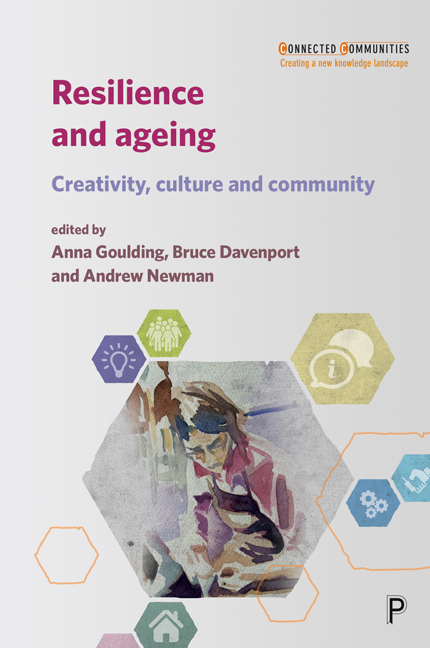Book contents
- Frontmatter
- Contents
- List of figures, tables and boxes
- Notes on contributors
- Series editors’ foreword
- Introduction
- one Setting the field: older people’s conceptualisation of resilience and its relationship to cultural engagement
- two Ages and Stages: creative participatory research with older people
- three Social connectivity and creative approaches to dementia care: the case of a poetry intervention
- four Narrative identity and resilience for people in later life with dementia living in care homes: the role of visual arts enrichment activities
- five After the earthquake: narratives of resilience, re-signification of fear and revitalisation of local identities in rural communities of Paredones, Chile
- six Integrating sense of place within new housing developments: a community-based participatory research approach
- seven Ageing in place: creativity and resilience in neighbourhoods
- eight Crafting resilience for later life
- nine Oral histories and lacemaking as strategies for resilience in women’s craft groups
- ten Objects of loss: resilience, continuity and learning in material culture relationships
- eleven Later-life gardening in a retirement community: sites of identity, resilience and creativity
- Index
eight - Crafting resilience for later life
Published online by Cambridge University Press: 19 April 2022
- Frontmatter
- Contents
- List of figures, tables and boxes
- Notes on contributors
- Series editors’ foreword
- Introduction
- one Setting the field: older people’s conceptualisation of resilience and its relationship to cultural engagement
- two Ages and Stages: creative participatory research with older people
- three Social connectivity and creative approaches to dementia care: the case of a poetry intervention
- four Narrative identity and resilience for people in later life with dementia living in care homes: the role of visual arts enrichment activities
- five After the earthquake: narratives of resilience, re-signification of fear and revitalisation of local identities in rural communities of Paredones, Chile
- six Integrating sense of place within new housing developments: a community-based participatory research approach
- seven Ageing in place: creativity and resilience in neighbourhoods
- eight Crafting resilience for later life
- nine Oral histories and lacemaking as strategies for resilience in women’s craft groups
- ten Objects of loss: resilience, continuity and learning in material culture relationships
- eleven Later-life gardening in a retirement community: sites of identity, resilience and creativity
- Index
Summary
Editorial introduction
This chapter explores the role of long-running craft activities in the lives of older women. The craft activities are understood as both creative and social experiences, and both aspects are seen as supporting resilience responses to the challenges of later life. Resilience is here understood as both individual and communal. The practice of making craft objects also forms the basis for narratives and meanings that contribute to resilient responses to later life.
Introduction
In this chapter, I draw upon my doctoral research, which examined the meanings that older people attach to their participation in group arts activities throughout their lives. The study (Reynolds, 2011) explored participation in a range of activities and focused on understanding the relationship between arts participation and social capital in later life. Social capital is increasingly recognised as a resource for resilience, and can be a characteristic of individuals or communities. The concept was popularised by Robert Putnam, who defines it as ‘connections among individuals – social networks and the norms of reciprocity and trustworthiness that arise from them’ (Putnam, 2000, p 19).
Commentators have since noted the lack of qualitative insights into how social capital is actually experienced (Blackshaw and Long, 2005) and the tendency to ignore gender differences (O’Neill and Gidengil, 2006). The social capital of older women in particular is largely neglected in the literature. While arts activities are recognised as a potentially valuable means of building social capital (Better Together, 2000), our knowledge of the nature of arts-generated social capital has previously been limited. Similarly, the relationship between arts-generated social capital and later-life resilience is also largely unexplored.
In order to address these issues, I focus in this chapter on the findings from ten interviews with female participants who take part in craft activities in groups. I will highlight the ways in which these women's relationships, widowhood, ill-health and a range of other factors have impacted upon their later-life participation. I will also discuss the networks of support and reciprocity arising from their arts engagement. In doing so, I provide insights into the distinctive nature of arts-generated social capital and the implications of this in terms of resilience.
- Type
- Chapter
- Information
- Resilience and AgeingCreativity, Culture and Community, pp. 181 - 202Publisher: Bristol University PressPrint publication year: 2018

